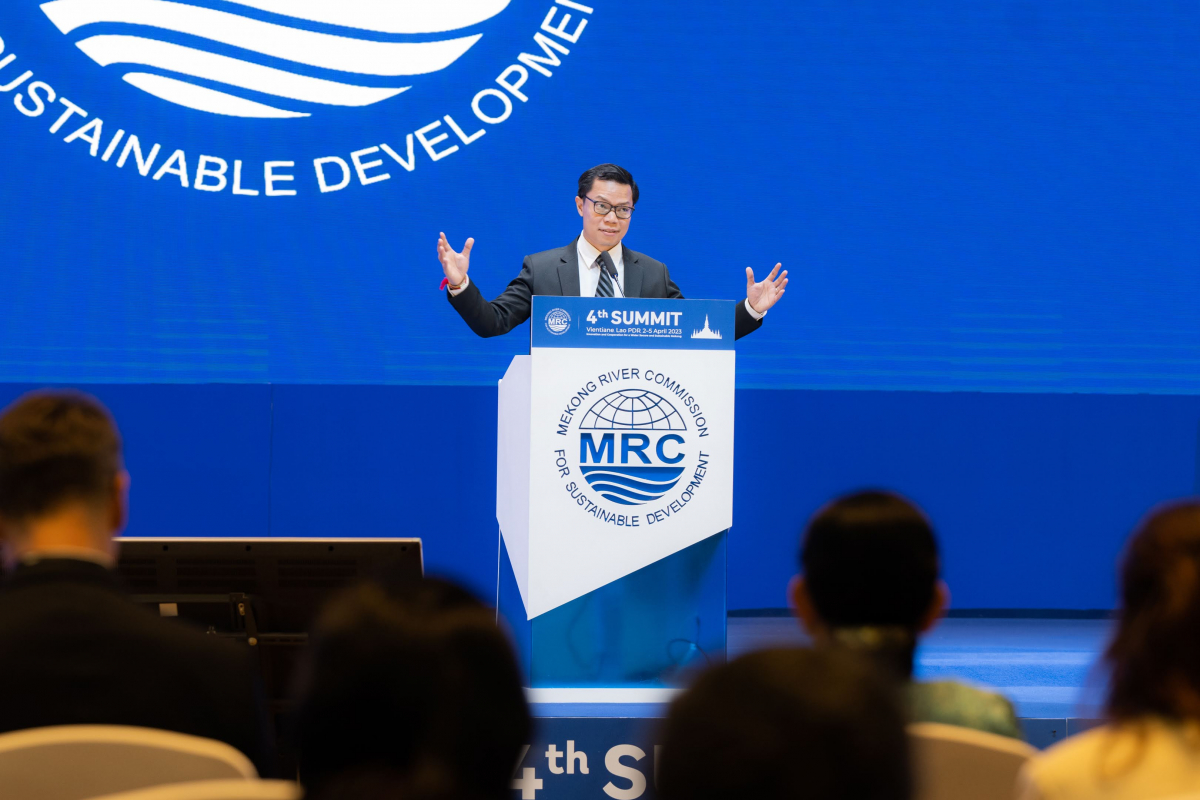Apr 5, 2023 | PRESS RELEASES

Vientiane, Lao PDR, Apr 5, 2023
Vientiane, Lao PDR, 4 April 2023 – In his second State of the Mekong Address, the top executive of the Mekong River Commission today described how – despite meaningful progress to better protect Southeast Asia’s largest river – it faces “alarming” trends in five critical areas: water flow regime, nourishing sediment, salinity intrusion, plastics pollution, and climate change-driven flood and drought.
Exactly one year ago, Dr Anoulak Kittikhoun, CEO of the MRC Secretariat, had sounded the alarm about how four straight years of low flow had created an “unprecedented challenge” for the river – and the vulnerable fishing and farming families who rely upon it. But heavier rainfalls and water-storage releases from upstream soon brought a brief respite. Yet many hurdles remain.
“Do I have good news this year? The answer is yes and no,” Kittikhoun told hundreds of experts, diplomats, and Mekong university students attending the 4th MRC Summit and International Conference. “In the year 2022, drought may have subsided, and we may have more rain, but the environment still faces several pressing challenges.”
Kittikhoun proceeded to make good on his pledge to always “Tell it like it is: what’s happening in the Mekong and what’s being done about it.” Yet, while the intergovernmental MRC is the leading forum for Water Diplomacy – on behalf of Member Countries Cambodia, Lao PDR, Thailand and Viet Nam – he urged the audience: “We cannot do everything. Our hope is to inspire all actors, in your respective roles and interests, to complement our efforts, fill our gaps, and/or do what we cannot.”
Starting with the “alarming news” first, Kittikhoun described each of the five troubling trends.
First, flow regime. According to MRC monitoring, the past decade has seen higher dry season flows, but lower flood season flows. This is most pronounced at Tonle Sap – the region’s largest, most productive lake, described as the “beating heart of the Mekong.” Yet last December, its outflow into the Mekong was one-half its 1995 level. “I repeat,” Kittikhoun emphasized, “only half.”
As for sediment transport, upstream sediment trapping and sand mining have dramatically reduced sediment loads in some parts by anywhere from 60% and 90%. This can impact both floodplain productivity and riverbank stability. Said Kittikhoun: “The Mekong cannot continue to lose sediment, otherwise it will cease to be the Mekong.”
Rising salinity is another concern, with parts of the Mekong Delta just two meters above sea level. Salinity concentrations above 1 gram/Litre already has consequences on irrigation. Yet now the MRC measures concentrations of quadruple that, at 4 gram/Litre, on 138 more square kilometers each year. This can spoil rice paddies, Kittikhoun said, with “implications for food security and export.”
Fourth, plastics pollution. The Mekong is already estimated to pour into the world’s oceans the 10th-largest amount of plastic debris: anywhere from 17.4 to 101 tonnes per day. “That’s like the size of a giant whale of waste thrown into the ocean each day,” Kittikoun said. Just as nefarious are the microplastics too tiny to see. Fish can ingest them, which can contaminate the human food chain.
Fifth, how climate change has exacerbated floods and drought. While the number of “heavy rainy days” has dwindled in the Lower Mekong River Basin, when they hit, they hit hard: In the wet years of 2018 and 2000, “The number of people suffering from floods increased to as many as 12 million.” Meanwhile, drought frequency increased in the 10 years, from 2010 to 2020, compared with the previous decade.
On the brighter side, water quality along the Mekong mainstream remains “Good” or “Excellent” in most places. Socio-economic growth and living standards have increased across the region, especially before the COVID pandemic. Kittikhoun also listed several MRC actions during 2022, which will soon be published in detail in that year’s Annual Report. For example: new guidelines for hydropower dam design, and transboundary environmental impact to facilitate fish movement; new navigation rules to foster greater river safety; innovative tools to better forecast floods and drought; a new monitoring station on the northern tip of the Basin, to quickly detect water changes; and the launch of a Joint Study – together with the Lancang-Mekong Cooperation – to develop a shared upstream-downstream understanding of the changing water-flow regime, which is a prerequisite for more effective cooperation. As Kittikhoun has said, this should be based on science, not feelings.
The MRC Secretariat CEO concluded his speech with a call for urgent action. Whereas last year he’d exclaimed “Our feet should be on fire,” today he says “We should not add fuel to fire. We call on the riparian countries, partners and stakeholders to act. But the way we choose to act, and the way our friends within the region and without, act, will determine the fate of the Mekong – and all of us.”
Read the news in Khmer, Lao, Thai or Vietnamese.
Note to Editors:
The MRC is an intergovernmental organization established in 1995 to boost regional dialogue and cooperation in the Lower Mekong River Basin. Based on the Mekong Agreement among Cambodia, Lao PDR, Thailand and Viet Nam, the MRC serves as both a regional platform for water diplomacy and a knowledge hub – to manage water resources and support sustainable development of the region.
-END-